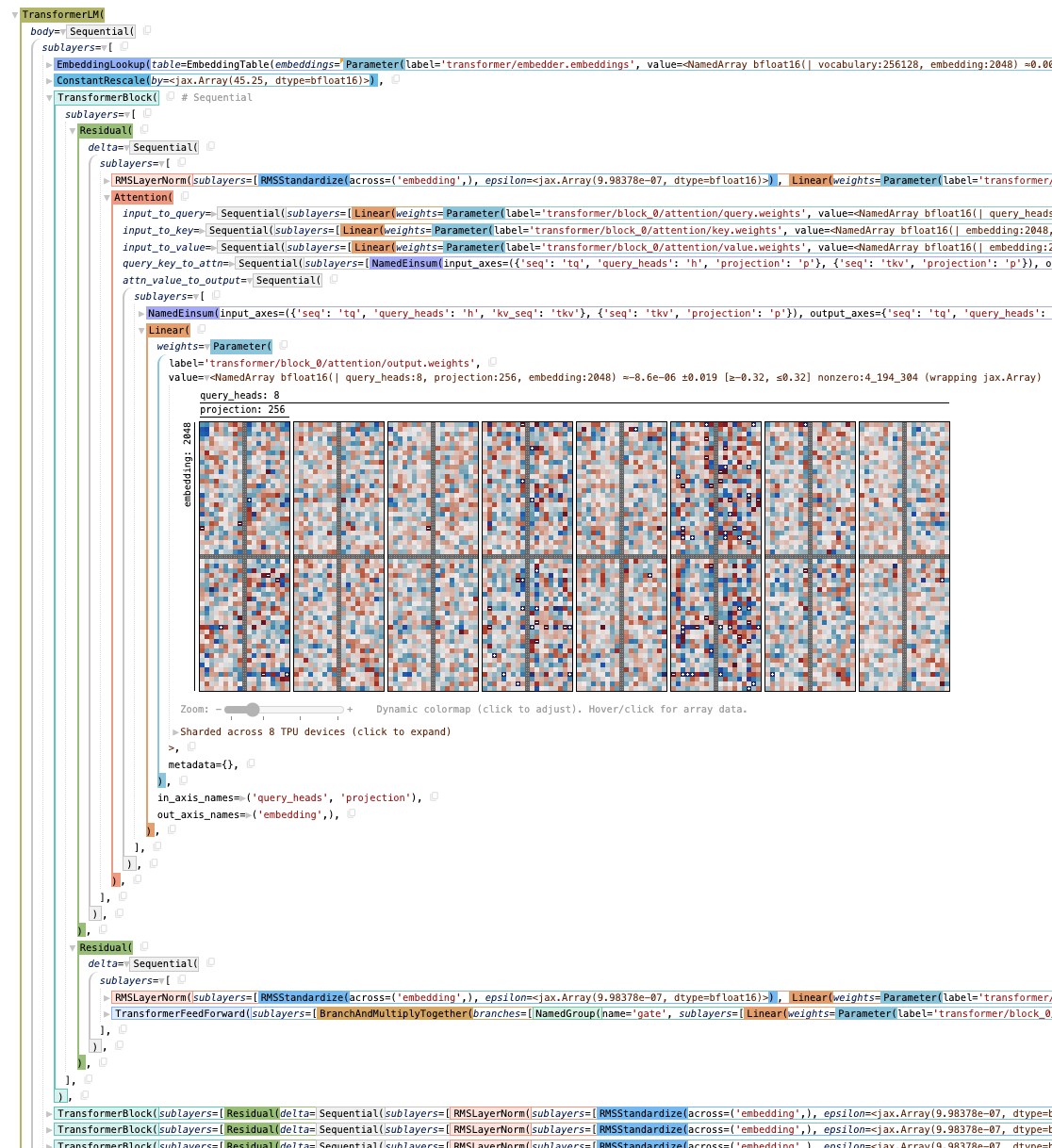盆 ("pen", tray) 栽 ("zai", planting) - an ancient Chinese art of forming trees and landscapes in miniature, also called penjing and an ancestor of the Japanese art of bonsai.
Penzai is a JAX library for writing models as legible, functional pytree data structures, along with tools for visualizing, modifying, and analyzing them. Penzai focuses on making it easy to do stuff with models after they have been trained, making it a great choice for research involving reverse-engineering or ablating model components, inspecting and probing internal activations, performing model surgery, debugging architectures, and more. (But if you just want to build and train a model, you can do that too!)
With Penzai, your neural networks could look like this:
Penzai is structured as a collection of modular tools, designed together but each useable independently:
-
A superpowered interactive Python pretty-printer:
-
Treescope (
pz.ts): A drop-in replacement for the ordinary IPython/Colab renderer, originally a part of Penzai but now available as a standalone package. It's designed to help understand Penzai models and other deeply-nested JAX pytrees, with built-in support for visualizing arbitrary-dimensional NDArrays.
-
Treescope (
-
A set of JAX tree and array manipulation utilities:
-
penzai.core.selectors(pz.select): A pytree swiss-army-knife, generalizing JAX's.at[...].set(...)syntax to arbitrary type-driven pytree traversals, and making it easy to do complex rewrites or on-the-fly patching of Penzai models and other data structures. -
penzai.core.named_axes(pz.nx): A lightweight named axis system which lifts ordinary JAX functions to vectorize over named axes, and allows you to seamlessly switch between named and positional programming styles without having to learn a new array API.
-
-
A declarative combinator-based neural network library, where models are represented as easy-to-modify data structures:
-
penzai.nn(pz.nn): An alternative to other neural network libraries like Flax, Haiku, Keras, or Equinox, which exposes the full structure of your model's forward pass using declarative combinators. Like Equinox, models are represented as JAX PyTrees, which means you can see everything your model does by pretty printing it, and inject new runtime logic withjax.tree_util. However,penzai.nnmodels may also contain mutable variables at the leaves of the tree, allowing them to keep track of mutable state and parameter sharing.
-
-
A modular implementation of common Transformer architectures, to support research into interpretability, model surgery, and training dynamics:
-
penzai.models.transformer: A reference Transformer implementation that can load the pre-trained weights for the Gemma, Llama, Mistral, and GPT-NeoX / Pythia architectures. Built using modular components and named axes, to simplify complex model-manipulation workflows.
-
Documentation on Penzai can be found at https://penzai.readthedocs.io.
[!IMPORTANT] Penzai 0.2 includes a number of breaking changes to the neural network API. These changes are intended to simplify common workflows by introducing first-class support for mutable state and parameter sharing and removing unnecessary boilerplate. You can read about the differences between the old "V1" API and the current "V2" API in the "Changes in the V2 API" overview.
If you are currently using the V1 API and have not yet converted to the V2 system, you can instead keep the old behavior by importing from the
penzai.deprecated.v1submodule, e.g. ::from penzai.deprecated.v1 import pz from penzai.deprecated.v1.example_models import simple_mlp
If you haven't already installed JAX, you should do that first, since the installation process depends on your platform. You can find instructions in the JAX documentation. Afterward, you can install Penzai using
pip install penzaiand import it using
import penzai
from penzai import pz(penzai.pz is an alias namespace, which makes it easier to reference
common Penzai objects.)
When working in an Colab or IPython notebook, we recommend also configuring Treescope (Penzai's companion pretty-printer) as the default pretty printer, and enabling some utilities for interactive use:
import treescope
treescope.basic_interactive_setup(autovisualize_arrays=True)Here's how you could initialize and visualize a simple neural network:
from penzai.models import simple_mlp
mlp = simple_mlp.MLP.from_config(
name="mlp",
init_base_rng=jax.random.key(0),
feature_sizes=[8, 32, 32, 8]
)
# Models and arrays are visualized automatically when you output them from a
# Colab/IPython notebook cell:
mlpHere's how you could capture and extract the activations after the elementwise nonlinearities:
@pz.pytree_dataclass
class AppendIntermediate(pz.nn.Layer):
saved: pz.StateVariable[list[Any]]
def __call__(self, x: Any, **unused_side_inputs) -> Any:
self.saved.value = self.saved.value + [x]
return x
var = pz.StateVariable(value=[], label="my_intermediates")
# Make a copy of the model that saves its activations:
saving_model = (
pz.select(mlp)
.at_instances_of(pz.nn.Elementwise)
.insert_after(AppendIntermediate(var))
)
output = saving_model(pz.nx.ones({"features": 8}))
intermediates = var.valueTo learn more about how to build and manipulate neural networks with Penzai, we recommend starting with the "How to Think in Penzai" tutorial or one of the other tutorials in the Penzai documentation.
If you have found Penzai to be useful for your research, please consider citing the following writeup (also avaliable on arXiv):
@article{johnson2024penzai,
author={Daniel D. Johnson},
title={{Penzai} + {Treescope}: A Toolkit for Interpreting, Visualizing, and Editing Models As Data},
year={2024},
journal={ICML 2024 Workshop on Mechanistic Interpretability}
}
This is not an officially supported Google product.
